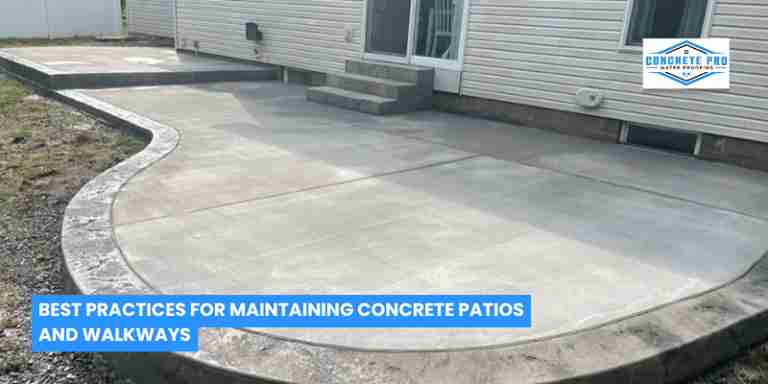
Concrete walkways and patios are highly functional for both residential and commercial properties. Even though concrete is popular for being low maintenance, in comparison to wood or natural rock, it also needs treatment regularly, to keep it looking its best and working effectively over a long period.
Inadequate maintenance can result in cracks, stains, weed growth and safety hazards. This blog discusses best practices for cleaning, sealing, repairing and protecting concrete surfaces.
Best Practices for Maintaining Concrete Patios and Walkways
There are many different ways to maintain concrete patios and walkways, but some are superior to others. Consider these as the most effective ways of ensuring that these elements last longer.
1. Routine Cleaning for Longevity
Sweep Regularly
Debris, dirt and leaves left on the surface to decompose can leave stains behind. Sweeping every week is recommended, to keep the surface fresh and minimize the organic load on it.
Pressure Wash Annually
Pressure washing eliminates deep rooted dirt and grime, algae and moss. Apply moderate pressure of 2,000-2,500 PSI, and keep a safe distance of 6-12 inches away, to prevent etching the concrete.
Treat Stains Immediately
- Oil and grease: Daub a degreaser or baking soda combined with dish soap, scrub the surface with a stiff brush, and rinse.
- Rust: Use a concrete specific rust remover.
- Mold, moss and algae: Mix vinegar and bleach (1:1) or vinegar and water (1:1). Wipe and hose off, with clean running water.
- Mildew: Clean with water and vinegar, for an environmentally friendly option.
Pro tip: It’s always a good idea to test cleaners in a small space first, to ensure that they do not discolor.
2. Protecting Surfaces with Sealing
Sealing concrete offers an isolating coating against moisture, stains and wear.
Choose the Right Sealer
- Penetrating sealers: These are most suitable for use outside, as they prevent moisture and block vapor.
- Acrylic sealers: These produce a glossy look that adds more color, but needs more frequent reapplication.
- Epoxy sealers: This is strong, but should not be used in exterior spaces, because it is nonbreathable.
Reapply Every 2-3 Years
Check the areas around seals once per year. When water no longer beads on the surface, it is time to reseal. Always wash and dry the concrete completely, prior to sealing.
Add Anti-Slip Protection
To be on the safe side, when working around a pool or in a place where moisture is likely to occur, add an anti-slip substance to your sealer.
3. Repairing Cracks and Surface Damage
Concrete may also develop flaws, despite frequent care. Repairs done promptly will increase the life of the surface.
Fill Small Cracks Flexible concrete caulk should be used on hairline cracks. Wipe off the crack and apply caulk. Flatten with a putty knife, leave to dry, and then seal over the caulk.
Patch Larger Cracks A patching compound should be used, when cracks are more than ¼ inch. Wipe thoroughly, blend as directed, and apply using a trowel.
Address Pitting and Spalling Heavy worn or flaking places can be resurfaced with an overlay or coating. More serious cases may require professional resurfacing or replacement of slabs.
Fix Uneven Surfaces Uneven slabs create hazards. Level surfaces can be restored without being replaced entirely, by professional lifting services such as mudjacking or foam injection.
4. Weed and Grass Control
Weeds affect the look of patios and pathways, and exacerbate cracks.
- Apply either natural or commercial solutions: Spray them with vinegar and water (3:1) or weed killers.
- Install weed barrier fabric: This is most suitable where one wants to pour new slabs, to avoid underground growth.
- Apply polymeric sand in joints: When laying a paver-style patio, polymeric sand is applied. Once dried, it prevents the growth of weeds and keeps the sand from being washed away.
5. Managing Water to Prevent Damage
Too much water is one of the major causes of cracks and erosion.
Ensure Proper Drainage The slope of patios and walkways should be directed away from (not toward) the house. In cases in which water collects, you may need to install either French drains or trench drains.
Keep Downspouts and Gutters Clean Roof runoff should be directed at least 3-4 feet off the concrete. Clean the gutters at least three times per year.
Use Soil and Borders Encase slabs with backfill soil to prevent erosion, or use gravel borders to absorb runoff.
6. Avoiding Winter Freeze-Thaw Damage
In colder climates a rise in freezes and thaws raises the deterioration rate.
- Seal before winter: Applying sealant in the fall will reduce water infiltration.
- Avoid salt deicers: Salt destroys concrete, by getting into pores; instead, use sand or magnesium chloride.
- Shovel promptly: Prevent snow from absorbing into concrete, by shoveling it off promptly. Use a plastic shovel, so that it does not scratch.
7. Enhancing Aesthetic Appeal
Concrete does not need to be dull grey. Think of improvements to increase aesthetics and functions.
- Staining or painting: This lends a polished touch and color.
- Stamped or stenciled patterns: Recreate the appearance of stone, tile or brick.
- Decorative edging and lighting: Mark out walks and enhance nighttime visibility.
When to Call a Professional
DIY repairs can go a long way; however, some problems are beyond the scope of an individual. If you notice any of the following, consult a professional:
- Big breaks or considerable settling
- Extreme pitting or spalling of the surface
- Structural issues that require replacement in the slabs
- Complete resurfacing, for either aesthetic or safety purposes
Concrete experts are equipped with specialized equipment and long-term solutions that help you avoid expensive errors.
Conclusion
Your patios and walkways are supposed to add value to your home, not stress you. Basic measures, such as cleaning and sealing, can help avoid expensive damage and make your concrete look fresh. Proper maintenance extends your investment for a long time. Need expert advice? Contact Concrete PRO.

